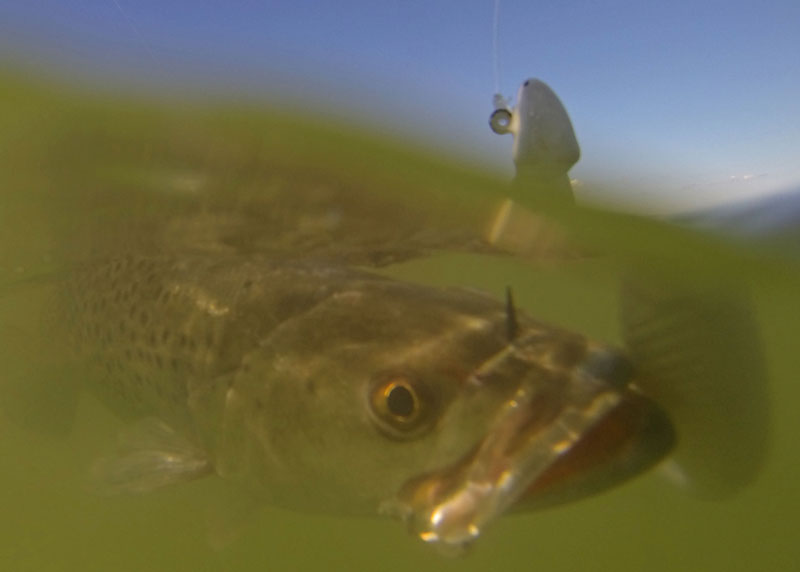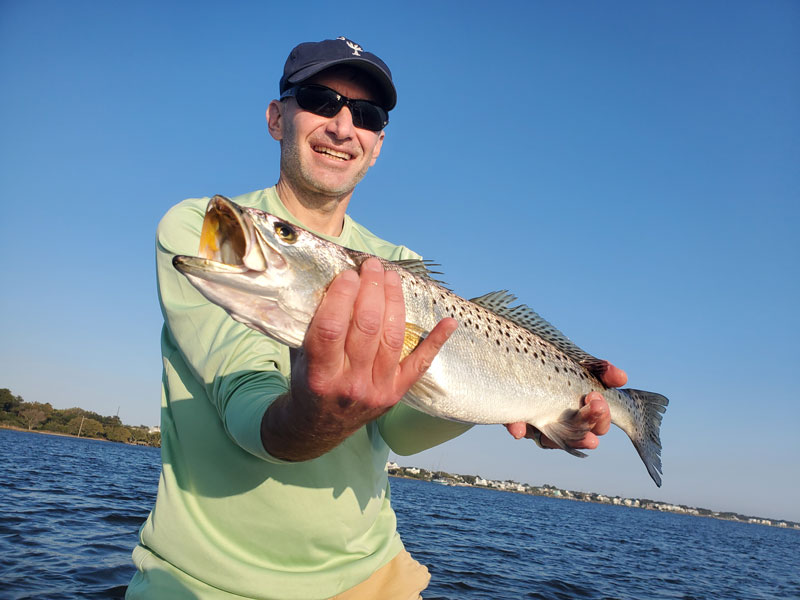The hunt for speckled trout during the warmer months can be particularly tricky. Many of our shallow water grass flats are ghosts of what they were in the spring, and increasing water temps have left the fish’s former haunts barren more often than not. If you’re set on slinging specks over the gunwale while other anglers set their sights on simpler species, here’s how to find them and catch them.

Tools for Trout Fishing
Before you worry about how to find these fish, you need to make sure you’re properly equipped. Speckled trout are notoriously leader-shy, have mouths softer than a freshly molted crab, and can give some of the subtlest bites in the Bay. A medium-light fast-action rod spooled with 15-pound braid paired with a 10-pound fluorocarbon leader is my weapon of choice. A light rod with fast action will allow you to feel subtle bites, but still have enough flex to maintain the integrity of the fish’s jaw on a hard strike or long run if your drag is set appropriately. I’ll upgrade to 15- or 20-pound leader if I’m fishing very heavy structure or there are bluefish around, but going any higher is a great way to send that trophy trout swimming in the opposite direction.
Keep it fairly simple when it comes to tackle. Pick up an assortment (and an excess) of jig heads ranging from a quarter ounce to one ounce, and soft plastic tails. I like paddletails and flukes for speckled trout, ranging from three to six inches depending on the class of fish I’m targeting and depth I’ll be fishing. Metal jigs are a good backup for especially tough jigging conditions (high wind and current) and have a much lower chance of getting bit off if there are bluefish in the area. Color isn’t a HUGE deal… but never leave the dock without pink.
Searching for Specks
Every season is unique, but specks can be found in the Chesapeake’s waters from Poplar Island south (and often up into Eastern Bay) by June most years. Wherever you start, plan on searching around the mouths of rivers or in the general vicinity of islands. I’ll bet quite a few of you raised an eyebrow when I said to bring one-ounce jigs and metal spoons, which brings us to locating fish.
During the peak of the summer, the shallows that were holding speckled trout in previous months can hit almost 90 degrees in the afternoons and the fish simply do not want to be there after that summertime sun is high in the sky. Don’t be afraid to get in the skinny for a sunrise bite or during a cooler, cloudy day. Otherwise, it’s time to start looking in deeper water, specifically near areas that hold fish in the shallows other times of the year. These are going to be the specks’ first stops on their way into more comfortable waters, and have the highest likelihood of holding fish. Oyster beds, docks, rock piles, and wrecks in 10-plus feet of clean water are go-to structure when the shallows aren’t producing. Bounce around between spots trying different kinds of structure in progressively deeper water until you find where the fish want to be that day, and try to replicate that bite elsewhere after locating some.
If you still can’t find the fish try running north or south until you find cleaner water, and don’t be afraid to cover a significant amount of water to find the right conditions. My best day of speckled trout fishing last year was the product of using this method to find them. We started in the shallows, but with a water temperature of 87 degrees, our normal spots were lifeless. We went on the hunt, fishing deeper and deeper. After a good bit of running, we came across a large school of speckled trout and bluefish on a wreck in 16’ of water off Tangier Island. We pulled out countless eating-sized bluefish, and around 10 speckled trout between 20” and 25” before moving on to another wreck nearby and having the same results.
These fish are often schooled up tight to the bottom in these scenarios, sitting in heavy current. If the area looks good, pick apart every piece of structure before moving on. Often, speckled trout will only be congregated around one small piece.

Jigging Deeper Structure
Remember those heavier heads? Tie on one of those bad boys and slap on a five- to six-inch soft plastic. Flukes and other straight tails sink a bit faster than paddle tails when rigged on the same head, and (in my opinion) have a much better vertical presentation. There’s no magic number for what size jighead you should use; every scenario is different based on wind, current, line diameter, depth… you get the drift. As a general rule of thumb, if you can’t reliably feel the bottom upsize your jig. If you’re constantly getting snagged, downsize. Position your boat so that you’ll drift past whatever structure you’re fishing, and cast short enough that your lure will hit bottom close enough to be in the strike zone without snagging.
If you have multiple capable anglers on the boat, you may need to stay at the helm while slowly moving around the structure. If you see fish on the electronics or your buddies start hooking up on a specific part of the structure, drop the trolling motor or anchor while positioned up-current of where they were catching, and start casting. Remember, trout in deeper water are usually right on the bottom. It’s imperative to keep your jig as close to it as possible, which can be pretty darn tricky. If you have newer anglers on the boat, upsize their jigs a bit to help them stay in the strike zone. They’re going to lose plenty of your precious jigheads, but it usually makes a significant difference if they aren’t getting bit while more experienced anglers are. Knowing how fast your jig is sinking makes life a whole lot easier. Drop it down vertically and count how long it takes to reach the bottom. Divide by your depth, and you have a rough fall rate of your lure through the water column.
Keep these tactics in mind when you head for the depths on those sunny summer days, and you’ll be sitting in speckled trout heaven in no time.
-By David Rudow